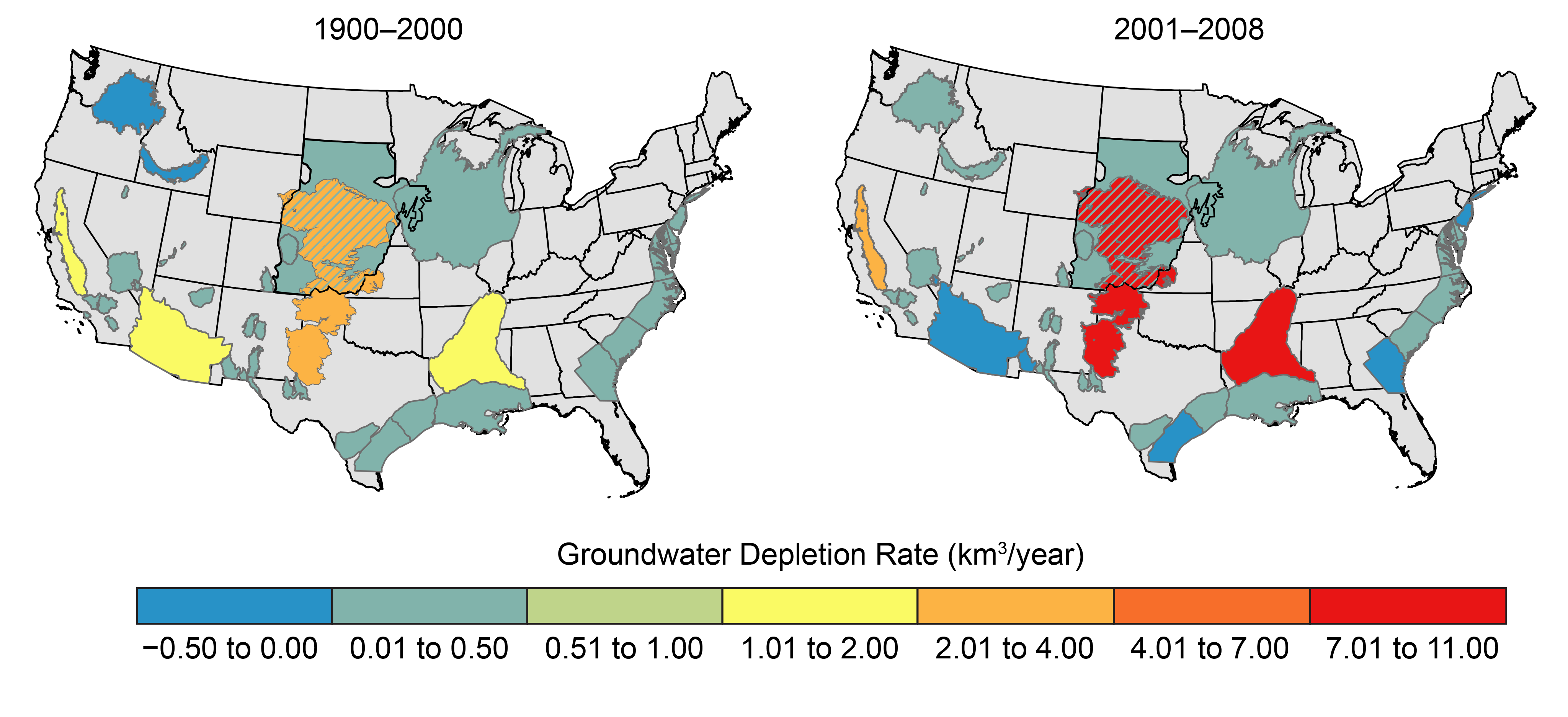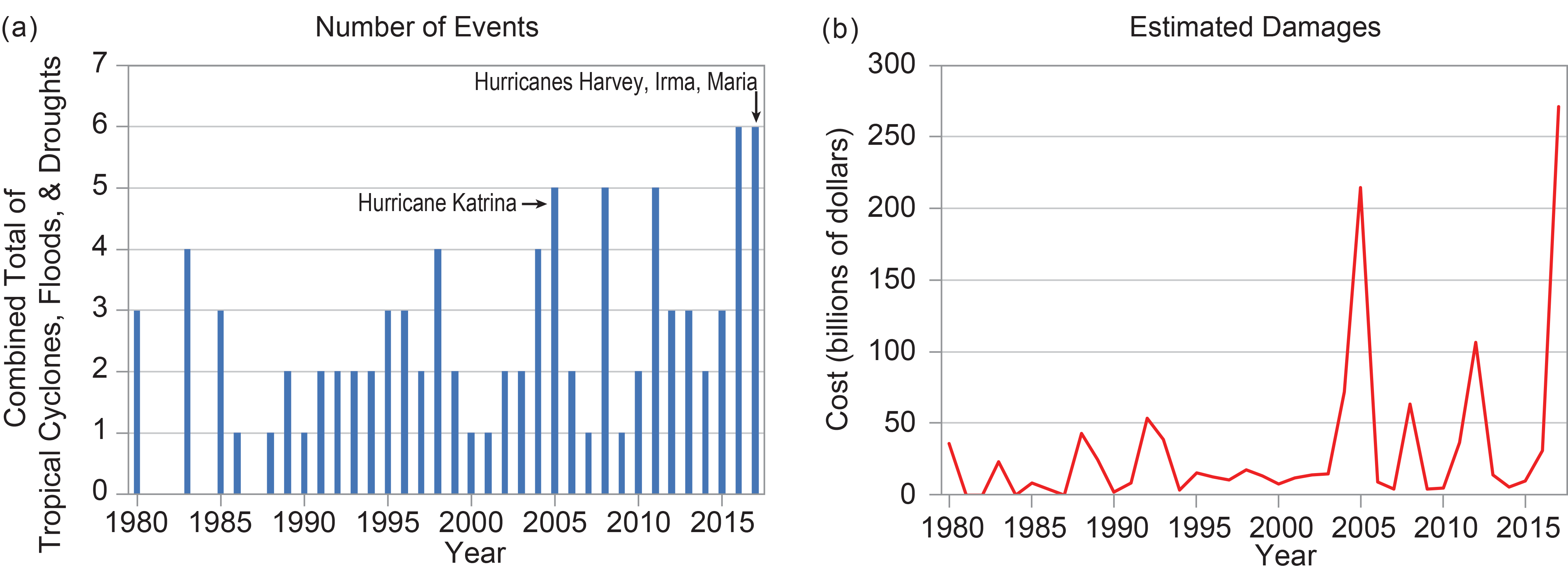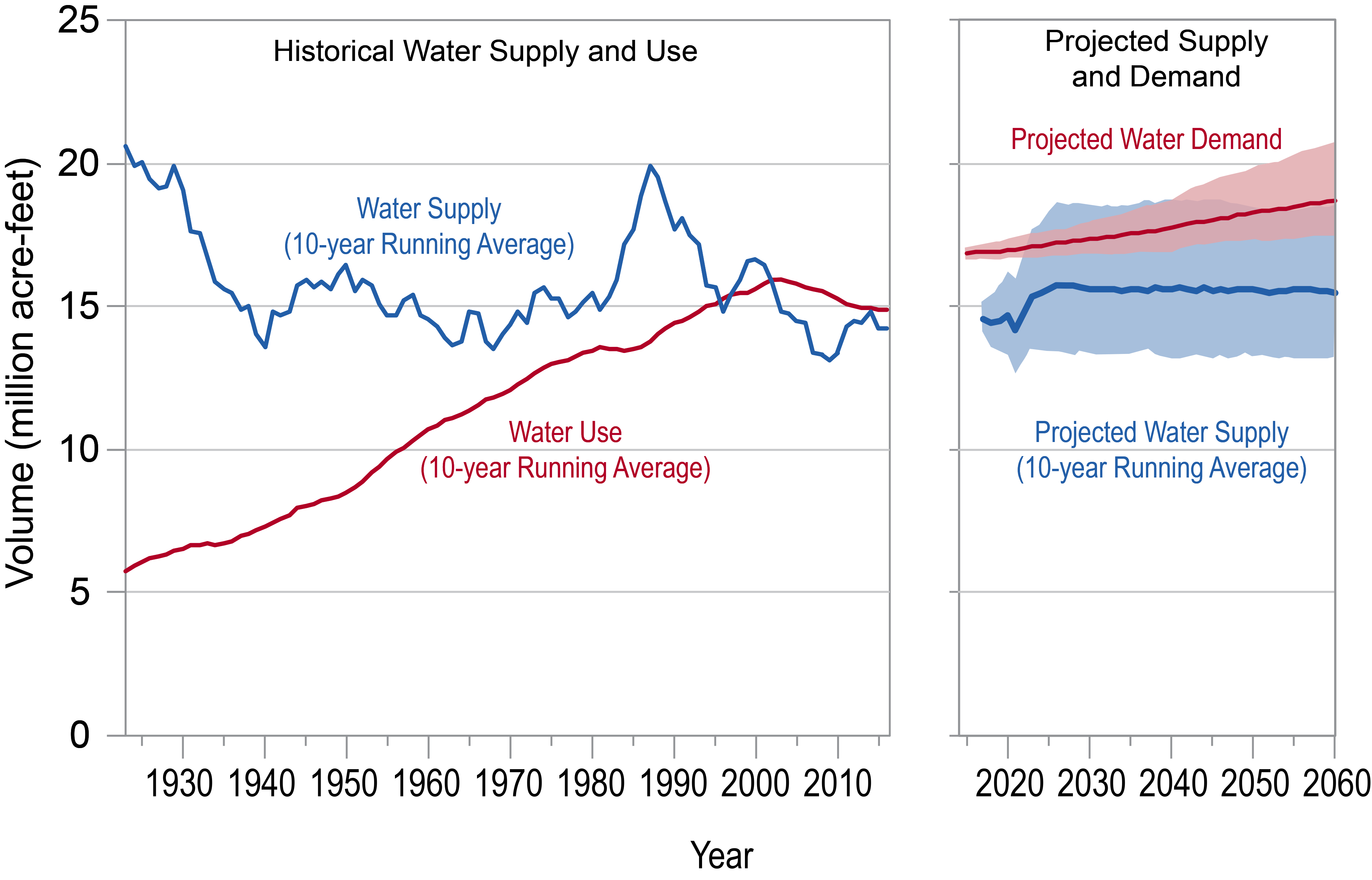Chapter authors were selected based on criteria, agreed on by the chapter lead and coordinating lead authors, that included a primary expertise in water sciences and management, knowledge of climate science and assessment of climate change impacts on water resources, and knowledge of climate change adaptation theory and practice in the water sector.
The chapter was developed through technical discussions and expert deliberation among chapter authors, federal coordinating lead authors, and staff from the U.S. Global Change Research Program (USGCRP). Future climate change impacts on hydrology, floods, and drought for the United States have been discussed in the Third National Climate Assessment6 and in the USGCRP’s Climate Science Special Report.35,36 Accordingly, emphasis here is on vulnerability and the risk to water infrastructure and management presented by climate variability and change, including interactions with existing patterns of water use and development and other factors affecting climate risk. The scope of the chapter is limited to inland freshwater systems; ocean and coastal systems are discussed in their respective chapters in this report.
Key Message 1: Changes in Water Quantity and Quality
Significant changes in water quantity and quality are evident across the country. These changes, which are expected to persist, present an ongoing risk to coupled human and natural systems and related ecosystem services (high confidence). Variable precipitation and rising temperature are intensifying droughts (high confidence), increasing heavy downpours (high confidence), and reducing snowpack (medium confidence). Reduced snow-to-rain ratios are leading to significant differences between the timing of water supply and demand (medium confidence). Groundwater depletion is exacerbating drought risk (high confidence). Surface water quality is declining as water temperature increases (high confidence) and more frequent high-intensity rainfall events mobilize pollutants such as sediments and nutrients (medium confidence).
Description of evidence base
Increasing air temperatures have substantially reduced the fraction of winter precipitation occurring as snow, particularly over the western United States,37,38,39,40,41,42,137 and warming has resulted in a shift in the timing of snowmelt runoff to earlier in the year.39,43,44,45,46
As reported in the Climate Science Special Report and summarized in Chapter 2: Climate, average annual temperature over the contiguous United States has increased by 1.2°F (0.7°C) for the period 1986–2016 relative to 1901–1960, and by 1.8°F (1.0°C) based on a linear regression for the period 1895–2016. Surface and satellite data are consistent in their depiction of rapid warming since 1979. Paleo-temperature evidence shows that recent decades are the warmest of the past 1,500 years. Additionally, contiguous U.S. average annual temperature is projected to rise. Increases of about 2.5°F (1.4°C) are projected for the next few decades in all emission scenarios, implying that recent record-setting years may be common in the near future. Much larger rises are projected by late century: 2.8°–7.3°F (1.6°–4.1°C) in a lower scenario (RCP4.5) and 5.8°–11.9°F (3.2°–6.6°C) in a higher scenario (RCP8.5).
Annual precipitation has decreased in much of the West, Southwest, and Southeast and increased in most of the Northern and Southern Great Plains, Midwest, and Northeast. There are important regional differences in trends, with the largest increases occurring in the northeastern United States. In particular, mesoscale convective systems (organized clusters of thunderstorms)—the main mechanism for warm season precipitation in the central part of the United States—have increased in occurrence and precipitation amounts since 1979 (see Easterling et al. 2017, Key Finding 135).
Heavy precipitation events in most parts of the United States have increased in both intensity and frequency since 1901 (see Easterling et al. 2017, Key Finding 235) and are projected to continue to increase over this century. There are, however, important regional and seasonal differences in projected changes in total precipitation: the northern United States, including Alaska, is projected to receive more precipitation in the winter and spring, and parts of the southwestern United States are projected to receive less precipitation in the winter and spring (see Easterling et al. 2017, Key Finding 335).
Projections indicate large declines in snowpack in the western United States and shifts to more precipitation falling as rain rather than snow in the cold season in many parts of the central and eastern United States (see Easterling et al. 2017, Key Finding 435).
The human effect on recent major U.S. droughts is complicated. Little evidence is found for a human influence on observed precipitation deficits, but much evidence is found for a human influence on surface soil moisture deficits due to increased evapotranspiration caused by higher temperatures (see Wehner et al. 2017, Key Finding 236).
Future decreases in surface (top 10 cm) soil moisture from anthropogenic forcing over most of the United States are likely as the climate warms under higher scenarios (see Wehner et al. 2017, Key Finding 336). Substantial reductions in western U.S. winter and spring snowpack are projected as the climate warms. Earlier spring melt and reduced snow water equivalent have been formally attributed to human-induced warming and will very likely be exacerbated as the climate continues to warm. Under higher scenarios, and assuming no change to current water resources management, chronic, long-duration hydrological drought is increasingly possible by the end of this century (see Wehner et al. 2017, Key Finding 436).
Even though national water withdrawal has remained steady irrespective of population growth,12 there is a significant spatiotemporal variability in water withdrawal (for example, a higher rate over the South) and water-use efficiency across the United States.13 Siebert et al. 201054 reported that irrigation use of groundwater has increased substantially over the past century and that groundwater use for irrigation in some areas has exceeded natural aquifer recharge rates.
Changes in air temperature and precipitation affect water quality in predictable ways. Attribution of water quality changes to climate change, however, is complicated by the multiple cascading, cumulative effects of climate change, land use, and other anthropogenic stressors on water quality. There has been a widespread increase in water temperatures across the United States.74,138 These trends are expected to continue in the future, with increased water temperatures likely across the country.76 Runoff from more frequent and intense precipitation events can increase the risk of pollutant loading as nutrients,69,70,71 sediment,66,67,68 and pathogens23,73 are transported from upland sources to water bodies. Pollutant loading is also strongly influenced by local watershed conditions (for example, land use, vegetative ground cover, pollutant sources). Increases in summer–fall water temperatures, excess nutrient loading events (driven by heavy precipitation events), and longer dry periods (associated with calm, quiescent water conditions) can expand the seasonal window for cyanobacteria and present an increased risk of bloom events.23,77
Figure 3.2 shows net, average volumetric rates of groundwater depletion (km3/year) in 40 assessed aquifer systems or subareas in the contiguous 48 states.4 Variation in rates of depletion in time and space within aquifers occurs but is not shown. For example, in the Nebraska part of the northern High Plains, small water-table rises occurred in parts of this area, and the net depletion was negligible. In contrast, in the Texas part of the southern High Plains, development of groundwater resources was more extensive, and the depletion rate averaged 1.6 km3/year.4
Major uncertainties
There is high uncertainty associated with projected scenarios, as they include many future decisions and actions that remain unknown. There also is high uncertainty with estimates of precipitation; this uncertainty is reflected in the wide range of climate model estimates of future precipitation. In contrast, because climate model simulations generally agree on the direction and general magnitude of future changes in temperature (given specific emission scenarios), there is a medium level of uncertainty associated with temperature projections. Overall, changes in land use are associated with a medium level of uncertainty. Even though there is low uncertainty regarding the expansion of urban areas, there is greater uncertainty regarding changes in agricultural land use. A medium level of uncertainty for water supply reflects a combination of high uncertainty in streamflow and low uncertainty in water demand. Uncertainty in water demand is low because of adaptation and increased water-use efficiency and because of water storage in reservoirs. Water storage capacity also reduces uncertainty in future groundwater conditions. Water temperature changes are relatively well understood, but other changes in water quality, particularly pollutant loads (such as nutrients, sediment, and pathogens), are associated with high uncertainty due to a combination of uncertain land-use changes and high uncertainty in streamflow and hydrologic processes.
Description of confidence and likelihood
Increasing temperature is highly likely to result in early snowmelt and increased consumptive use. Uncertainty in precipitation and emission scenarios leads to low confidence in predicting water availability and the associated quality arising from changes in land-use scenarios. However, surface water and groundwater storage ensures medium confidence in water quantity and quality reliability, but spatial disparity in water efficiency could be better addressed through increased investment in water infrastructure for system maintenance.
Key Message 2: Deteriorating Water Infrastructure at Risk
Deteriorating water infrastructure compounds the climate risk faced by society (high confidence). Extreme precipitation events are projected to increase in a warming climate (high confidence) and may lead to more severe floods and greater risk of infrastructure failure in some regions (medium confidence). Infrastructure design, operation, financing principles, and regulatory standards typically do not account for a changing climate (high confidence). Current risk management does not typically consider the impact of compound extremes (co-occurrence of multiple events) and the risk of cascading infrastructure failure (high confidence).
Description of evidence base
Heavy precipitation events in most parts of the United States have increased in both intensity and frequency since about 1900 and are projected to continue to increase over this century, with important regional differences (Ch. 2: Climate).35,97 Detectable changes in some classes of flood frequency have occurred in parts of the United States and are a mix of increases and decreases (Ch. 2: Climate).6,139 However, formal attribution approaches have not established a significant connection of increased riverine flooding to human-induced climate change, and the timing of any emergence of a future detectable anthropogenic change in flooding is unclear (Ch. 2: Climate). There is considerable variation in the nature and direction of projected streamflow changes in U.S. rivers (Ch. 2: Climate).6,140
Infrastructure systems are typically sized to cope with extreme events expected to occur on average within a certain period of time in the future (for example, 25, 50, or 100 years), based on historical observations.141 There is substantial concern about the impacts of future changes in extremes on the existing infrastructure. However, the existing operational design and risk assessment frameworks (for example, rainfall intensity–duration–frequency, or IDF, curves and flood frequency curves) are based on the notion of time invariance (stationarity) in extremes.109,110
Variability in sea surface temperatures influences atmospheric circulation and subsequently affects the occurrence of regional wet and dry periods in the United States.142,143,144,145,146 Reconstructed streamflow data capture the extreme dry/wet periods beyond the instrumental record, but a limited literature has considered their application for water management.147,148
A number of models have been developed to incorporate the observed and/or projected changes in extremes in frequency analysis and risk assessment.94,103,104,105,149,150,151,152 The appropriateness of a fixed return period for IDF curves or for flood/drought frequency analysis is also questioned in the literature.7,14,134,153 This chapter has not evaluated the existing methods in the literature that account for temporal changes in extremes, and the issue warrants more investigation in the future.
Previous studies show that compound extreme events can have a multiplier effect on the risks to society, the environment, and built infrastructure.112,154 Current design frameworks ignore this issue and mainly rely on one variable at a time.92,154,155 For example, coastal flood risk assessment is primarily based on univariate methods that consider changes in terrestrial flooding and ocean flooding separately.108,109,111 Few studies have offered frameworks for considering multiple hazards for the design and risk assessment of infrastructure.112,154 Expected changes in the frequency of extreme events and their compounding effects can have significant consequences for existing infrastructure systems.
Major uncertainties
There are high uncertainties in future floods because of uncertainties in future long-term regional/local precipitation and uncertain changes in land use/land cover, water management, and other non-climatic factors that will interact with climate change to affect floods. There also are high uncertainties in future water supply estimates because of uncertainties in future precipitation. Drought increase due to combined precipitation and temperature change has a moderate uncertainty.
Description of confidence and likelihood
There is high confidence in the presence of a strong relationship between precipitation and temperature, indicating that changes in one will likely alter the statistics of the other and hence the likelihood of occurrence of extremes. The aging nature of the Nation’s water infrastructure is well documented. Not all aging infrastructure is deteriorating, however, and many aging projects are operating robustly under changing conditions. Unfortunately, no national assessment of deteriorating infrastructure or the fragility of infrastructure relative to aging exists. For example, the U.S. Army Corps of Engineers (USACE) has assessed how climate change projections with bias correction compare with the nominal design levels of USACE dams; however, this represents only a fraction of the Nation’s 88,000 dams. While age may be an imperfect proxy for deterioration, it is used here to call attention to the general concern that many elements of the Nation’s water infrastructure are likely not optimized to address changing climate conditions. There is high confidence that deteriorating water infrastructure (dams, levees, aqueducts, sewers, and water and wastewater treatment and distribution systems) compounds the climate risk faced by society.
Studies show that compound extreme events will likely have a multiplier effect on the risk to society, the environment, and built infrastructure. Sea level rise is expected to increase in a warming climate. Sea level rise adds to the height of future storm tides, reduces pressure gradients that are important for transporting fluvial water to the ocean, and enables greater upstream tide/wave propagation and coastal flooding.
There is high confidence in the existence of the interannual and decadal cycles but medium confidence in the ability to accurately simulate the joint effects of these cycles and anthropogenic climate change for water impacts.
Currently, coastal flood risk assessment is primarily based on univariate methods that consider changes in terrestrial flooding and ocean flooding separately, which may not reliably estimate the probability of interrelated compound extreme events. The expected changes in the frequency of extreme events and their compounding effects will likely have significant consequences for existing infrastructure systems. Because of the uncertainties in future precipitation and how extreme events compound each other, there is medium confidence in the effects of compound extremes (multiple extreme events) on infrastructure failure.
Key Message 3: Water Management in a Changing Future
Water management strategies designed in view of an evolving future we can only partially anticipate will help prepare the Nation for water- and climate-related risks of the future (medium confidence). Current water management and planning principles typically do not address risk that changes over time, leaving society exposed to more risk than anticipated (medium confidence). While there are examples of promising approaches to manage climate risk, the gap between research and implementation, especially in view of regulatory and institutional constraints, remains a challenge.
Description of evidence base
There is wide documentation in the scientific literature that water management practice and engineering design use the observed historical record as a guide to future expectations. This implies that significant departures from those expectations would pose greater-than-anticipated risks, and scenario analyses have demonstrated this to be the case, particularly in studies of large water supply systems. In particular, the Climate Science Special Report5 notes the potential for increased clustering (for example, heat waves and drought) or sequences of extremes and rapid transitions in climate. There is a growing literature that documents the use of robustness-based planning approaches, especially for water supply planning but also for coastal planning. These approaches provide promising methodologies for addressing climate change in water planning, although their complexity and cost—and limited planning resources—may be impediments to wide-scale adoption.
The literature also provides examples of some more innovative approaches applied to managing risks in an adaptive manner, including updating reservoir operations,116,126,156 employing financial instruments for risk transfer or financial risk management,123,157 and the use of adaptive management.117 However, the lack of broader-scale adoption and wider demonstration prevents more conclusive statements regarding the general utility of these approaches at this time.120
Major uncertainties
The key uncertainty in assessing the current state of preparation of the Nation’s water infrastructure and management for climate change is the lack of public data collected about key performance and risk parameters. This includes the state of water infrastructure, including dams, levees, distribution systems, storm water collection, and water and wastewater treatment systems. For some of these systems, current performance information may be available, but there is little knowledge of what future performance limitations may be. Furthermore, much of this information is not publicly available, although it may be collected by the many local and state agencies that operate these infrastructure systems. A large number of case studies have illustrated that observed and projected changes in climate could place systems at risk in ways that exceed current expectations.
Description of confidence and likelihood
The Key Message is stated with medium confidence due to the limited assessment that has been performed on water infrastructure systems and management regimes, and due to the nascent and limited assessment of proposed adaptive responses.





